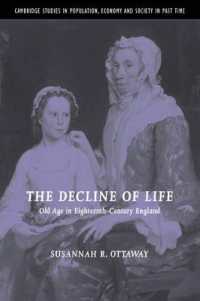Full Description
Whilst schools are transforming their physical and virtual environments at a relatively glacial pace in most countries across the globe, universities are under extreme pressure to adapt to the rapid emergence of the virtual campus. Competition for students by online course providers is resulting in a rapidly emerging understanding of what the nature of the traditional campus will look like in the 21st century.
The blended virtual and physical technology enabled, hybrid learning environments now integrate the face-to-face and online virtual experience synchronously and asynchronously. Local branch campuses are emerging in city and town centres and international branch campuses are growing at a rapid rate. There is increasing pressure at various levels, i.e. the city, the urban and the campus, to create formal and informal learning spaces as well as re-purposing the library and social or third-spaces.
Many new hybrid campus developments are not based on any form of rigorous scholarly evidence. The risk is that many of these projects may fail. In taking an evidence-based approach this book seeks to align with the model of translational research from medical practice, using a modified 'translational design' approach. The majority of the chapter material comes from the scholarly work of doctoral graduates and their dissertations.
This book is the second in a series on the evidence-based translational design of educational institutions, with the first volume focussing on schools. This volume on Higher Education covers the city to the classroom and those elements in between. It also explores what the future might look like as judgements are made about what works in campus planning and design in our rapidly changing virtual and physical worlds.
Contributors are: Neda Abbasi, Ronald Beckers, Flavia Curvelo Magdaniel, Mollie Dollinger, Robert A. Ellis, Kenn Fisher, Barry J. Fraser, Kobi (Jacov) Haina, Rifca Hashimshony, Leah Irving, Marian Mahat, Saadia Majeed, Jacqueline Pizzuti-Ashby, Leanne Rose-Munro, Mahmoud Reza Saghafi, Panayiotis Skordi, Alejandra Torres-Landa Lopez, and Ji Yu.
Contents
Foreword: University Campuses as Complex Adaptive Assemblages
Wes Imms
Preface
Notes on Contributors
List of Figures and Tables
Part 1: Emerging Trends in Higher Education and their Impact on the Physical Campus
Introduction to Part 1
Kenn Fisher
1. The Translational Design of Universities: From Campus to Classroom
Kenn Fisher
2. Scoping the Future of the Higher Education Campus
Kenn Fisher
3. Designing the University of the Future
Rifca Hashimshony and Jacov Haina
4. The Relationship between Innovation, Campuses and Cities: Lessons about Synergy from the Development of the MIT in Cambridge
Flavia Curvelo Magdaniel
5. "The Third Teacher" of the XXI Century: Educational Infrastructure, its Problems and Challenges
Alejandra Torres-Landa Lopez
Part 2: The Socio-Cultural Implications in Aligning Virtual and Physical Learning Spaces
Introduction to Part 1
Kenn Fisher
6. Virtual Worlds in Higher Education: Embodied Experiences of Academics
Leah Irving
7. The Assessment of the Psychosocial Learning Environment of University Statistics Classrooms
Panayiotis Skordi and Barry J. Fraser
8. Learning Space Design in Higher Education
Ronald Beckers
9. Implementing Grounded Theory in Research on Blended Learning Environments
Mahmoud Reza Saghafi
10. Modelling Learning Space and Student Learning in Higher Education: An Evidence-Based Exploration
Ji Yu
11. Mind the Gap: Co-Created Learning Spaces in Higher Education
Marian Mahat and Mollie Dollinger
Part 3: Evaluating Learning Space/Place Planning and Design, and the Implications for Future Campus Planning and Design
Introduction to Part 1
Kenn Fisher
12. A Critical Review of Post 2012 Scholarly Literature on the Evidence-Based Design and Evaluation of New Generation Active Learning Environments
Kenn Fisher and Robert A. Ellis
13. Designing for the Future: The Post-Occupancy Evaluation of the Peter Jones Learning Centre
Jacqueline Pizzuti-Ashby
14. Defining Quality in Academic Library Spaces: Criteria to Guide Space Planning and Ongoing Evaluation
Neda Abbasi and Kenn Fisher
15. At-scale Innovative University Learning Spaces of the Future: An Approach to Evidencing and Evaluating What Works?
Leanne Rose-Munro and Saadia Majeed
16. Afterword: 21st C Learner Modalities
Kenn Fisher








